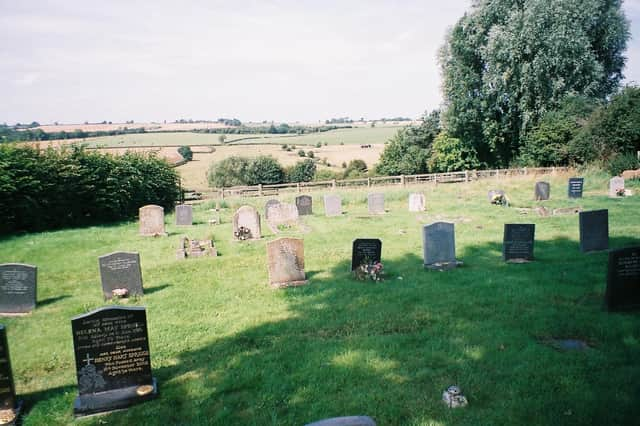Former Advertiser reporter remembers the lost rural sports that enlivened many an afternoon in Churchover


You may recall an article I wrote a few weeks ago about the games and pastimes of my Churchover childhood.
This page wouldn’t qualify as a nostalgia piece if there wasn’t a degree of wistfulness and longing associated with a subject such as this, so it will come as no surprise that I once again return to this theme.
Advertisement
Hide AdAdvertisement
Hide AdThe fact is that there were a few pastimes that I missed out from my previous list. Yes, we mentioned five stones, hop-scotch, snail racing and hobby horses, but such was my enthusiasm in reliving the joy of partaking in a particular pursuit, that I missed out a couple of games that will now have almost certainly died out in this neck of the north-east Warwickshire woods.
Many of you will be familiar with the French game of petanque, which is related to boules, and a number of other similar sports. These games involve the use of shiny metal balls and, if my memory serves me correctly, a much smaller one that we would know as a ‘jack’ on this side of the Channel.
Anyone who has ever travelled to France will have noticed sandy pits in most towns and villages, where the locals pit their skills against each other in games that bear more than a passing resemblance to our much-loved game of bowls.
Right. This was how the Churchover version worked, only instead of metal balls, old horseshoes were used, the object of the game being very simple – you had to cast your ‘shoe’ so that it hooked round a wooden peg that had been fixed into the ground beforehand.
Advertisement
Hide AdAdvertisement
Hide AdThere would be several of these pegs, and I’m afraid this is where my memory starts to let me down. Suffice to say that none of this was as easy as it sounds, no small degree of skill being required to get enough ‘hits’ in order to win the game.
Back in the 1950s and 60s, ‘Uncle’ George Hirons lived over the road from me in the Five Houses, and he was lucky enough to live in the end cottage, which meant there was a large lawn between his garden path and farmer Jack Mace’s barns.
And it was here that George would, weather permitting, take on all comers during the summer months. Just to make the game that little bit more interesting, there might be a ‘halfpenny stake’ by each contestant. All right, it might not have been Monte Carlo – or even a case of ‘Churchover or bust’ – but this small concession to notions of gambling certainly sharpened the contestants’ concentration levels.
Interestingly, old horseshoes of all sizes could regularly be found in the fields around the village in those days, throwbacks to the days before mechanisation and when the horse was king.
Advertisement
Hide AdAdvertisement
Hide AdNow we come to another pastime that I missed from my previous list - cow flop hurling. And yes, you did read me right – I did say ‘cow flop hurling’. Anyway, what follows is true. I give you my word as a Warwickshire gentleman…
This is how cow flop hurling worked. First of all, cut a stout alder stick and trim to about five feet in length. Each end should be gently rounded, not – I stress – cut to a point.
The choice of alder is crucial. Alder is a fairly heavy timber, but also has resilience and ‘spring’, essential qualities for the job in hand.
Next, together with your opponent, scour the fields for your ideal cow pat. This must not be a recent deposit, for you are looking for a much older specimen that has formed a thick crust on the top in the sun and the wind of several days.
Advertisement
Hide AdAdvertisement
Hide AdOnce located, place the rim of your wellington boot underneath the lip of the crust, and in a lifting motion, gently prise free from the lower part of the pat.
Once this is done, manoeuvre your crust so that it can be pierced with the alder stick. (NB: You must avoid making a large hole in the pat – the entry point must fit snugly over the end of your stick).
Then, with a swinging motion, not unlike that of a golfer, rotate the stick and its bovine deposit cargo until maximum velocity is achieved, and then launch your pat skywards. The winner is the contestant who has gained the greatest distance with his mucky missile.
Down the years, I have on occasion told people about this old Churchover pastime. The reactions vary, but usually it’s a mixture of consternation, incredulity and – occasionally – disbelief.
Advertisement
Hide AdAdvertisement
Hide Ad‘Uncle’ George Hirons, by the way, was also an expert at cow flop hurling. He taught me the secrets of the sport, almost certainly in the large meadow on the outskirts of Churchover that is now sadly lost forever, covered by gigantic warehouses and the nearby motorway.
But whenever I think about those innocent days, I always smile to myself and reflect on an era when pleasures were simple, remember summer days without end… and ‘Uncle’ George Hirons, a man of limitless talents and endless sporting prowess.
John Phillpott’s book about growing up in Churchover – Beef Cubes and Burdock – is available from booksellers and the internet.